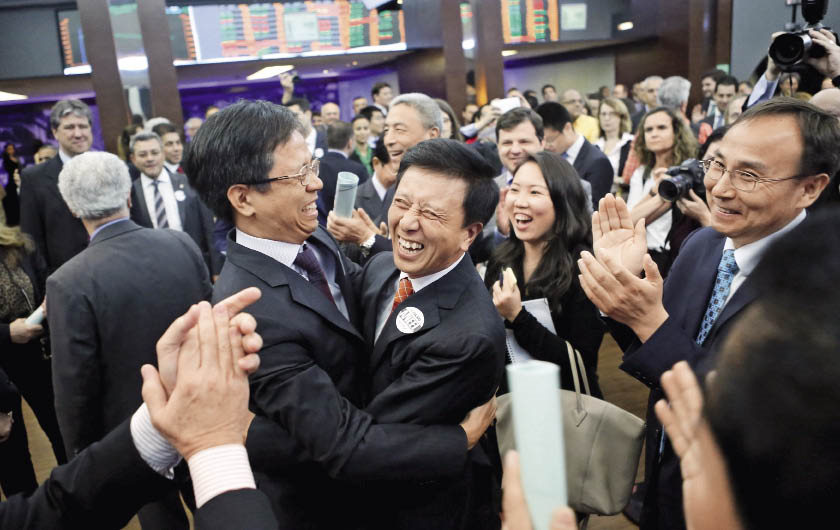China Plays Growing Role in Global Governance
China Today by Wang Yiwei, December 20, 2016 Adjust font size:
Proposing Institutional Public Goods
China created the Asian Infrastructure Investment Bank (AIIB) and other new multilateral financial institutions, as well as facilitating quota and governance reforms of the International Monetary Fund (IMF).
The AIIB, the BRICS New Development Bank, and the Belt and Road Initiative all originated in China, but their benefits extend around the world. The AIIB is stimulating the reform of the international financial system and revamping 21st century global governance with the motto: “Lean, clean, and green.”
The Belt and Road Initiative focuses on building a collectively beneficial network, working out new modes of cooperation and creating a cooperative platform. It advocates policy coordination, connectivity of facilities, unimpeded trade, financial integration, and people-to-people bonds as their five major goals, so as to build a “green, healthy, intelligent, and peaceful” Silk Road – one of China’s strategies to improve global governance.
The Belt and Road Initiative intends to establish a comprehensive Eurasian transportation network comprising railways, roads, aviation routes, oil and gas pipelines, electricity lines, and a telecommunications network.
The construction of this infrastructure will contribute to the formation of an economic corridor which will facilitate the development of architecture, metallurgy, energy resources, finance, telecommunication, logistics, and tourism. A huge transportation system will connect the Asia-Pacific region, an important engine of global economic growth, with the world’s largest economic zone, the European Union.
When the two are connected they will form the longest economic corridor in the world, creating more room for development and new opportunities on the Eurasian continent. It will boost the economies of East Asia, West Asia and South Asia by facilitating trade and investment and deepening economic and technological cooperation. The establishment of free trade zones will lead to the formation of an enormous Eurasian market, which will transform the current global economic landscape and promote the establishment of a new international political and economic order.
The Belt and Road Initiative, which China regards as an attempt to explore ways of improving global governance, has drawn the attention of major international economic organizations. Since it was proposed three years ago, over 100 countries and organizations have opted to participate. China has signed cooperation agreements with over 30 countries along the proposed “Belt and Road” route, and agreed to cooperate in production capacity with over 20 countries. International organizations like the UN have been very supportive. Financial cooperation in the form of the AIIB and the Silk Road Fund has been enhanced and a number of significant projects gradually implemented.

China’s State Grid Brazil Holding won the contract on July 17, 2015 to build and operate the second power transmission linking the giant Belo Monte hydro power plant to the national Brazilian grid.
China is a permanent member of the International Electrotechnical Commission (IEC). The State Grid Corp. is one of the institutions qualified to set the international standards in all areas of power engineering. According to Lü Shirong, deputy director of the International Department of the State Grid, the company has investments across Asia, South America, Europe, and Oceania.
With regard to international cooperation in production capacity, the company started by working as a subcontractor for power transmission and transformation projects in developing countries in Asia and Africa and exporting equipment to those countries, Lü said. After years of development, the company was able to independently take on national power grid projects in many countries. Its Engineering Procurement Construction (EPC) and equipment allowed it to enter high-end markets like the EU, and its ultra-high-voltage technology is now used around the world.
The intention behind the Belt and Road Initiative is not to start a new system that will challenge the existing international order. On the contrary it is conducive to solving current world problems.
First, it is helping to boost economic development in Africa, whose development was impeded by colonialism, imperialism, and hegemonism. China proposed a “three networks and industrialization” program in Africa, which means building three major transport networks – high-speed rail, highways, and regional aviation – to accelerate infrastructure construction. The program is widely applauded across the continent.
Second, it helps fuel the world economy, which has been lackluster since the outbreak of the global financial crisis, with the growth rate of trade lower than that of the global economy. The initiative is expected to boost consumption and strike a balance between real and fictitious capital.
Third, it helps solve a main obstacle to globalization – that of insufficient interconnectivity. The initiative promotes policy coordination, road connectivity, unimpeded trade, the circulation of wealth, and cultural understanding between Europe, Asia, and Africa. It also advocates the development of a third-party market, creating a win-win and even multi-party winning situation.
